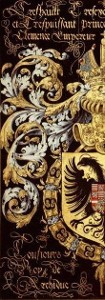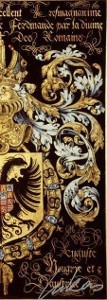
|
Qualifications of the Holy Roman Emperor The Emperor had to be a worthy man, aged 18 or more, reside in the Empire, be of noble birth (all four grandparents had to be noble, according to the Schwabenspiegel), and of lay status (this was not explicitly stated). No law required that he be Catholic, and, although the text in a number of laws assumes that the emperor is Catholic, jurists saw no obstacle to the choice of a Protestant prince. Nor did he have to be German, as the examples of Alfonso of Castile and Charles V showed. By the 17th century, however, it seemed wise for any candidate to possess an estate within the boundaries of the Empire: when the French weighed in 1648 whether to let Alsace remain within the Empire, it was because it might allow the king of France to be a candidate for the throne. Similarly, in 1737 the duke of Lorraine was allowed to retain the county of Falkenstein so as not to jeopardize his future candidacy (Schoell 1:151, 2:252). The office was not hereditary, but elective. However, from 1453 to 1740, a Habsburg was always Emperor. The last Habsburg Charles VI died leaving only daughters, and the Elector of Bavaria was elected as Charles VII in 1742, but he died in 1745 and Charles VI's son-in-law Francis of Lorraine was elected emperor in 1745; until the end of the Empire in 1806, the imperial crown was in the Habsburg-Lorraine family. The reign began with the swearing of the Wahlkapitulation, or electoral capitulation, a kind of contract between the Emperor and the Empire. Even a minor could take the oath (as did the 12-year old Joseph I in 1690), although he also promised to renew his oath upon assuming power. This oath preceded the coronation, led by the archbishop of Mainz. The imperial cities took an oath of loyalty at the time of coronation, but not the states of the empire, since each took such an oath at the time they inherited their fief. The reign ended by death, abdication (Charles V in 1555) or deposition of the emperor. The latter could be declared by the Reichstag, although earlier texts (Schwabenspiegel and Sachsenspiegel, as well as the Golden Bull c5, §3) speak of a jurisdiction of the Count Palatine of the Rhine over the emperor, which was never formally abolished. Successors and Replacements: the King of the Romans, the Vicars of the Empire, When a successor was elected during the lifetime of the Emperor, he bore the title of King of the Romans (Rex Romanorum, römischer König). The election of a successor in the lifetime of the empire was practised up to Frederic II's sons Heinrich in 1220 and Konrad in 1237. It was then abandoned except for Wenceslas in 1376. The Habsburgs resumed it, with Charles V's brother Ferdinand's election in 1531, followed by Maximilian II in 1562, Ferdinand III in 1636, Ferdinand IV in 1653 [who died before his father], and Joseph I in 1690. The King of the Romans bore his arms on a shield on the breast of a single-headed eagle sable (as opposed to the double-headed eagle of the Emperor). He had royal rank and came immediately after the Emperor in precedence. He succeeded the emperor immediately, without need for another coronation or Wahlkapitulation, since he had already been crowned and sworn a capitulation at the time of his election. He also ruled the empire in case the emperor was incapacitated (as did Joseph I in the last days of his father's reign), but stayed out of the government of the empire otherwise, according to the oath he took upon election. If no king of the Romans existed, and if either the Emperor was incapacitated or under age (sede pleana), or there was no emperor (sede vacante, case of an interregnum), the imperial authority was held jointly by two Imperial Vicars (Reichsvikarien), although exercised in the name of the emperor in the first case. By virtue of the Golden Bull, these were the Elector Palatine and the Elector of Saxony, and each had special authority over a part of the empire, depending on which type of law was in force: the Elector Palatine in regions of Franconian law (Franconia, Swabia, the Rhine, southern Germany), while the Elector of Saxony in regions of Saxon law (Saxony, Westphalia, northern Germany, Hannover). The boundaries between the two areas (particularly in Hesse, Julich, Cleve, Berg, Liége, Ostfriesland) were disputed until 1750, and some regions (Bohemia, Austria) did not recognize any vicar. In Italy, the titular vicar was the duke of Savoy. In 1623 the Elector Palatine lost his electorship to Bavaria, and in 1648 a new electorship was created for him. Thereafter Bavaria and Pfalz were in dispute as to who was vicar. In the 1659 interregnum both claimed to be vicars and issued documents on that authority, but the arch-chancellor and the other vicar recognized Bavaria, as did emperor Leopold after his election. In 1724 a family pact between the two branches of the Wittelsbach family set forth joint exercise of the vicariate, but this was not accepted by the Reichstag. In 1745 the two branches agreed to alternate, with Bavaria starting first in the 1745 interregnum. This was accepted by Francis I after his election and by the electors, and later confirmed in 1752 by the Reichstag. In 1777 the Bavarian branch became extinct and the agreement moot. The imperial vicars exercised the powers of the emperor that were not explicitly reserved to his person, and in doing so were bound by the terms of the deceased emperor's capitulation. They handled all matters of grace: legitimations, emancipations, privileges, ennoblements and titles, etc. They exercised the emperor's judicial powers, they collected taxes in his name, nominated to ecclesiastical benefices, and invested vassals with imperial fiefs, whether inherited or newly conceded (except for principalities and Fahnlehen). The emperor was formally obliged to ratify the acts of the vicars after his election, although there are instances of such acts being repealed by the Reichshofrat. The vicariate ended once the new emperor had sworn to uphold his electoral capitulation.
|





